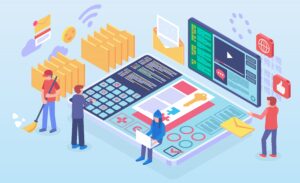It can be used in traffic control, robotics, self-driving vehicles, smartphone apps, websites, and a variety of other applications. It is critical to track developments in your field to ensure that you stay up to date on standards and protocols, especially in the field of coding. Programmers of all specialities can benefit greatly from staying up to date on new developments and following industry-leading blogs and websites.
Over the last decade, the programming industry has changed considerably. When it comes to technological projects, organizations now have an ever-increasing number of options to consider. So, what does this mean in terms of software development and programming?
1. What is the meaning of programming?
The process of creating a set of instructions that tells a computer how to perform a task is known as programming. Programming is the process of writing instructions that tell a computer what to do and how to do it. Programming ‘languages’ are used to create software, websites, applications, and much more. There are hundreds of programming languages, each with its own set of rules, or “syntax.”
Programming languages are commonly classified into ‘programming paradigms,’ which are different approaches to viewing and accessing data. However, several languages are now considered ‘multi-paradigm,’ which means they accept multiple programming paradigms.
Object-Oriented Programming, Functional programming, and Procedural programming are the most common paradigms, while there are others:
1.1 Object-Oriented Programming

Object-Oriented programming is dependent on objects, sometimes known as “data structures,” which contain both data (properties or characteristics) and code (procedures or methods). Objects can have both data and executable code in most OOP languages. Each object is distinct, and even if it is a clone of another object, its variables may vary from those of any other object. Java, Python, C++, Ruby, and C# are examples of Object-Oriented Programming languages.
1.2 Procedural Programming
Procedural programming is a top-down or linear programming paradigm. A huge program is split down into smaller, more manageable components called procedures or functions in procedural programming. Procedural code, in essence, is the code that specifies a device how to do a task in logical steps. BASIC, Pascal, and C are all examples of procedural programming languages.
1.3 Functional Programming

Mathematical functions and irreversible data, or data that cannot be modified after it is generated, are the core of functional programming. It lacks state (stored memory), which means that in a functional program, the only thing that changes is the input. In functional programming, the sequence of the code might theoretically be changed, and the result or ‘output’ would remain the same. For example, if you add six numbers together, it doesn’t matter what sequence you multiply them in; the overall result will be the same. Swift, Haskell, Scala, and F# are examples of functional programming languages.
2. Programming in today’s business environment
From websites and databases to APIs and gateways, to mobile and desktop applications, software development encompasses the construction of a wide variety of digital tools and systems.
Every development project starts with a clear business need. Indeed, the business chooses to automate parts of its procedures, develop new communication channels, or improve the customer experience by providing a digital product. A software development project could be as simple as setting up a website in its most basic form.
The company may decide whether to outsource the development or do it internally based on the task’s intricacy and available resources. In our forum, ‘Selecting the proper software partner: Critical elements for customized software development,’ we go over the possibilities available to the company seeking to develop software.
2.1 Desktop Application Development
A desktop application is a program that runs on a computer. Of course, there are already millions of programs accessible that meet many of the user’s shared. Businesses, on the other hand, frequently require custom software to complete a very specific objective. A programming resource may be required to construct an application in this case. C++, Java, C#, and VB.NET are common languages for desktop software development. Since these languages are object-oriented, programmers can mix pre-defined blocks of code to construct a functionality.
2.2 Website Development

The only individual supposed to access a company’s website in the early days of the Internet was the webmaster, who was expected to have programming skills in HTML, CSS, JavaScript or ActionScript to develop pages. They will also need to learn back-end programming tools like PHP, Perl, or ASP, as well as databases like MySQL or SQL Server, inability to engage with databases and run server-side scripts. There are several solutions for building and managing websites with comprehensive HTML-generating toolkits these days, with development frameworks like ASP.NET and CMS systems like Umbraco, WordPress, and Joomla! making the process easier and faster.
2.3 Database Development

Creating tables of data within the database, as well as processes to retrieve it, is a standard step while designing databases. A relational database management system, such as MySQL, Oracle, SQLite, or Microsoft SQL Server, underpins databases. These systems vary in cost and are built for different applications.
2.4 Middleware Development
Middleware is computer software that extends the services provided by the operating system to software applications. Middleware connects or integrates disparate systems, optimizing the user experience by giving the impression of utilising a single system despite the presence of multiple components and applications. Large enterprise systems are typically built by binding together several smaller systems using middleware.
2.5 Mobile Application Development
Since there are multiple various operating systems and technical needs at action, developing apps for mobile and tablet devices necessitates different abilities than developing desktop software. For iOS, Swift and Objective-C are used, while Java is utilized for Android. Cross-platform development tools, such as Xamarin and React Native, are also available.
2.6 API Development
Web application development progressively makes utilization of RESTful APIs, which use JSON as a data exchange format, for system-to-system or client-to-server interaction. Developers must also be familiar with XML-based web service standards like SOAP and WSDL.
3. Difference in Programming: Now and a Decade Ago
Technology production is an essential part of an evolving world. This means that computer programming is exceptionally important for our future as a global society. Cloud computing was still in its early stages ten years ago. Smartphones were becoming more prevalent, and end-user tablets were just entering the market. All of these things are now fundamental to how we think about application development.
Software as a Service (SaaS) has changed our expectations – both as individuals and as enterprises – to the extent that we appear to be able to instantly scale up or down our utilization, turn access off and on, carry apps with us wherever we go, and use them on any device. As a result, programmers must now be able to code in multiple programming languages or integrate with multiple programming languages instead of just one. Even though the development environment has evolved, and many new coding platforms have been introduced to make the process easier, the number of interfaces with other systems and technologies is rapidly increasing. Clients must guarantee that their software development partners have the necessary expertise to account for the diversity of their application requirements.
4. The principle of codeless programming
There are numerous development tools available depending on the intended eventual outcome, many of which necessitate little or no previous coding knowledge or programming. Zoho Creator, Intuit Quickbase, and Salesforce are some examples of software-creation tools with a straightforward, visual interface. It’s fair to demonstrate that the world doesn’t want as many programmers anymore, given the availability of codeless drag-and-drop software creation solutions.
Programmers are still in high demand. But, their technical skills must evolve to stay updated with the latest market. Instead of providing coding and development services, they should now act as consultants, helping clients through the maze of possibilities and assisting them in choosing the optimal solution.
5. Future Impact of Programming
The use of the Internet of Things and AI are two trends that are expected to destabilize the technology landscape in the coming years. Companies that establish solutions to capitalize on the ever-increasing mass of information accessible to them are likely to be better fully integrated to compete on a larger scale. We also anticipate that companies will shift even more toward self-service applications for key internal and external processes, which will increase productivity and increase operational efficiency.
Computer programming is important today because so much of our world is automated. Humans need to be able to control the interaction between people and machines. Since computers and machines can do things so efficiently and accurately, we use computer programming to harness that computing power.
Regardless of the future, it will be important for organizations to have a reliable development partner on hand to offer customized services to meet the needs of a constantly changing market.
TechDel is the best mobile app and web application development company based in London. We have a team of talented developers and designers who specialize in producing exceptional apps that help your business thrive. For more details, please visit TechDel Mobile App Services and Contact Us.

